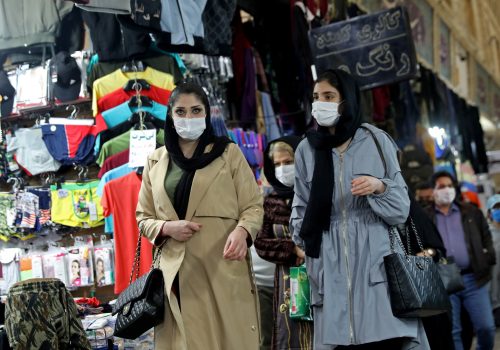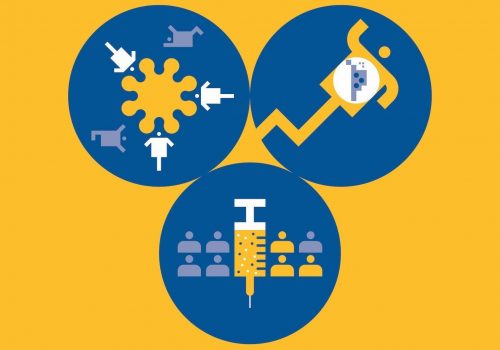The future is here: A guide to the post-COVID world 04/30/2021
Welcome to your guide to where the world is headed during the pandemic era and beyond, from Andrew Marshall. Each week, we’ll bring you the latest and most significant expert insights and international news about how coronavirus is reshaping international affairs. To stay updated each week, sign up to the newsletter here.
Let’s take a spin around the globe, in seven minutes or less.
In top stories this week:
- Scenarios for Latin America’s post-COVID future.
- While India faces rising cases, the US and EU set out reopening plans.
- Whatever happened to the flu season, anyway?
- But first, an update on the pandemic’s impact on global education—and how to keep children from slipping through the net—from Natasha Somji, Senior Policy Manager at The ONE Campaign
The big story
This week’s key theme: We’ll have to get smarter about the world’s lost potential
At the height of the pandemic, 1.6 billion children were out of school. It was exhausting for parents and frustrating for kids. While children are starting to return to class in the United States and United Kingdom, the long-term implications could run much deeper. For example, one study estimated the education impact of World War II on earnings was still being felt forty years later.
While children in rich countries are returning to in-person school, children in the poorest countries will be hit the hardest. One-third of children globally do not have access to any form of remote learning, meaning lockdowns put a pause on their education progress. For some, that pause will become a permanent stop. In South Sudan, children missed 16 percent of their total schooling.
A new tool launched this week from The ONE Campaign, in partnership with the Global Partnership for Education (GPE) and Save the Children, quantifies the impact. The Lost Potential Tracker monitors, in real time, the number of children who reach their tenth birthday without being able to read and understand a simple story since 2015, when world leaders made a commitment to quality education for all children.
Age ten is a critical milestone: it’s the age at which children should be switching from learning to read to reading to learn. These skills propel a lifetime of self-directed learning, influencing their ability to earn, innovate, improve their opportunities, and contribute to their societies. If children don’t hit that milestone, all that potential slows and inequalities deepen.
The tool shows that this year, over half the world’s ten-year-olds, or some seventy million children, will slip through the net. Today, tomorrow, and every day after, 193,000 children will celebrate their tenth birthday without being able to read their birthday card. That’s nearly twice the capacity of The Rose Bowl or FC Barcelona’s Camp Nou, the largest football stadium in Europe.
COVID-19 exacerbated a pre-existing crisis: an additional 11.4 million children will fall through the learning net this year. But crises can be hinge moments—when we pause, wake up, and realize we need to change something.
ONE is calling for governments to rewrite this story and invest in the next generation. The first stop is fully funding the GPE, which needs five billion dollars this year to catalyze much-needed reforms in low-income countries’ education systems by investing in areas like quality teacher training and teaching at the right level.
This project is part of ONE’s Africa COVID-19 Tracker—which highlights the economic, social, and governance impacts of the pandemic and acts to change them. You can sign up for their weekly update at ONE.org/Aftershocks.
Subscribe to The future is here: A guide to the post-COVID world
Sign up for a weekly roundup of top expert insights and international news about how coronavirus is reshaping international affairs.

The world in brief
Insights from across the planet, in ten bullets or fewer
- India is overwhelmed by COVID-19. India is the focus of world attention as COVID-19 rages, with total cases passing eighteen million. “The world’s second most populous nation is in deep crisis, with hospitals and morgues overwhelmed,” reported Reuters. “We are witnessing a crime against humanity,” novelist Arundhati Roy wrote in a moving essay in the Guardian. The United States, United Kingdom, and other countries have sent assistance, including oxygen concentrators and ventilators. “But the international community is only just now starting to respond,” wrote Vox, underlining how the pandemic requires more co-operation across international borders. “There is a split scenario unfolding as the world battles the pandemic,” wrote CNN’s Aditi Sangal. “India’s Covid outbreak is a global problem that needs a coordinated response.”
- The United States and Europe plan for life after the pandemic. While many countries struggle with death tolls and infection rates, some countries and cities are starting to plan for life after COVID-19. New York City Mayor Bill de Blasio said the city would “fully reopen” this summer. “Our plan is to fully reopen on July 1. We are ready for stores to open, for businesses to open, offices, theaters—full strength,” he said on MSNBC’s “Morning Joe.” French President Emmanuel Macron was set to announce new plans today. Starting June 2, the French government plans to replace the current state of health emergency with a “transition regime” that will run until October 31.
- A deluge of bankruptcies? Europe’s top financial stability supervisor, the European Systemic Risk Board, warned this week of a possible “tsunami” of corporate insolvencies. Financial support from governments has aimed at propping up companies that suffered in the pandemic, and that aid is tailing off. “It recommended that governments take a series of actions to mitigate the risk of a wave of corporate insolvencies, including developing more targeted policies to boost the solvency of otherwise viable companies and streamlining debt restructuring and insolvency procedures,” the Financial Times reported. Last year, the credit insurance firm Euler Hermes predicted “an insolvency time bomb” in 2021, with US bankruptcies projected to increase 57 percent from 2019 to 2021.
- How we can prepare for the next pandemic: “Preparedness works,” says Tom Frieden, president and CEO of Resolve to Save Lives and former US Centers for Disease Control and Prevention director, in a new report. Epidemics That Didn’t Happen argues for improved investment and research now. “We need to invest money, we need to invest in technical support, we need to invest in strengthening institutions,” he told STAT news.
- What’s up with the influenza that we never got? Have you had the flu this year? Most of us haven’t, and that’s interesting. “Since the novel coronavirus began its global spread, influenza cases reported to the World Health Organization have dropped to minuscule levels,” reports Scientific American. “The reason, epidemiologists think, is that the public health measures taken to keep the coronavirus from spreading also stop the flu. Influenza viruses are transmitted in much the same way as SARS-CoV-2, but they are less effective at jumping from host to host.”
The inside scoop
Insights from the Atlantic Council
Andrew Marshall is the Vice President of Communications for the Atlantic Council. He leads the Council’s media, digital, and editorial efforts, and coordinates the way the Council talks with its key communities.



